Marketing Essentials Report: Analyzing Aldi's Marketing Function
VerifiedAdded on 2022/09/05
|10
|2828
|22
Report
AI Summary
This report provides a comprehensive analysis of the marketing function at Aldi, a leading discount supermarket. It begins by outlining the key roles and responsibilities of the marketing department, focusing on its mission to expand market share and offer high-quality products. The report then delves into a situation analysis, evaluating Aldi's strengths, such as its discount leadership and customer support, alongside its weaknesses, like low margins and employee attrition. Opportunities and threats, including evolving customer demands and competition from major retailers, are also examined. The core of the report explores Aldi's marketing strategies, including cost leadership and differentiation focus, alongside the 7Ps of the marketing mix: product, place, price, promotion, people, process, and physical evidence. It details how Aldi uses these elements to achieve its business objectives, emphasizing its commitment to value, quality, and customer satisfaction. The report also analyzes how the marketing function interrelates with other departments, such as finance, HR, and production, highlighting the importance of marketing research and the marketing information system (MIS) in supporting organizational goals. Finally, it compares Aldi's approach to that of competitors like Walmart, underscoring the importance of understanding the market and customer satisfaction in achieving success.
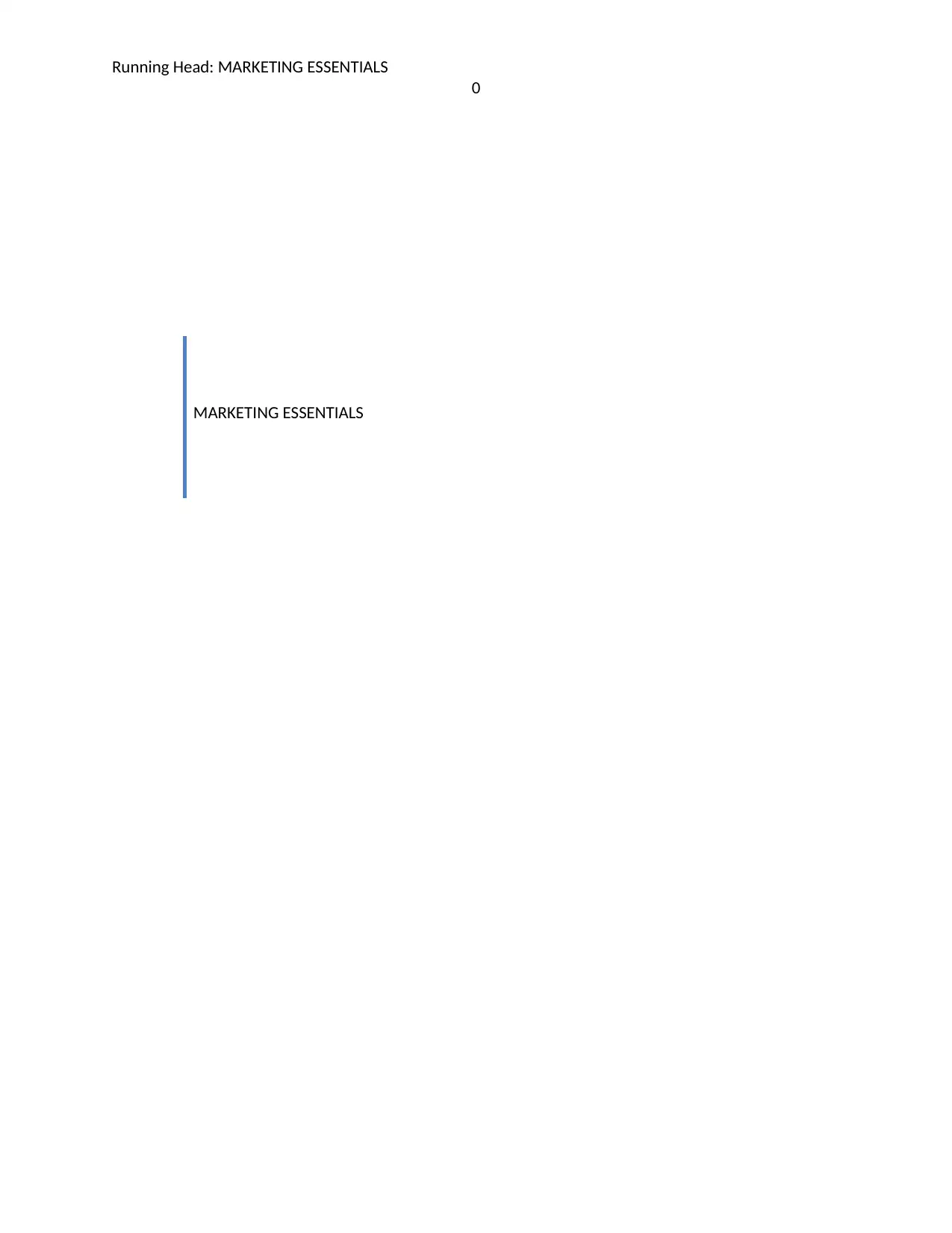
Running Head: MARKETING ESSENTIALS
0
MARKETING ESSENTIALS
0
MARKETING ESSENTIALS
Paraphrase This Document
Need a fresh take? Get an instant paraphrase of this document with our AI Paraphraser
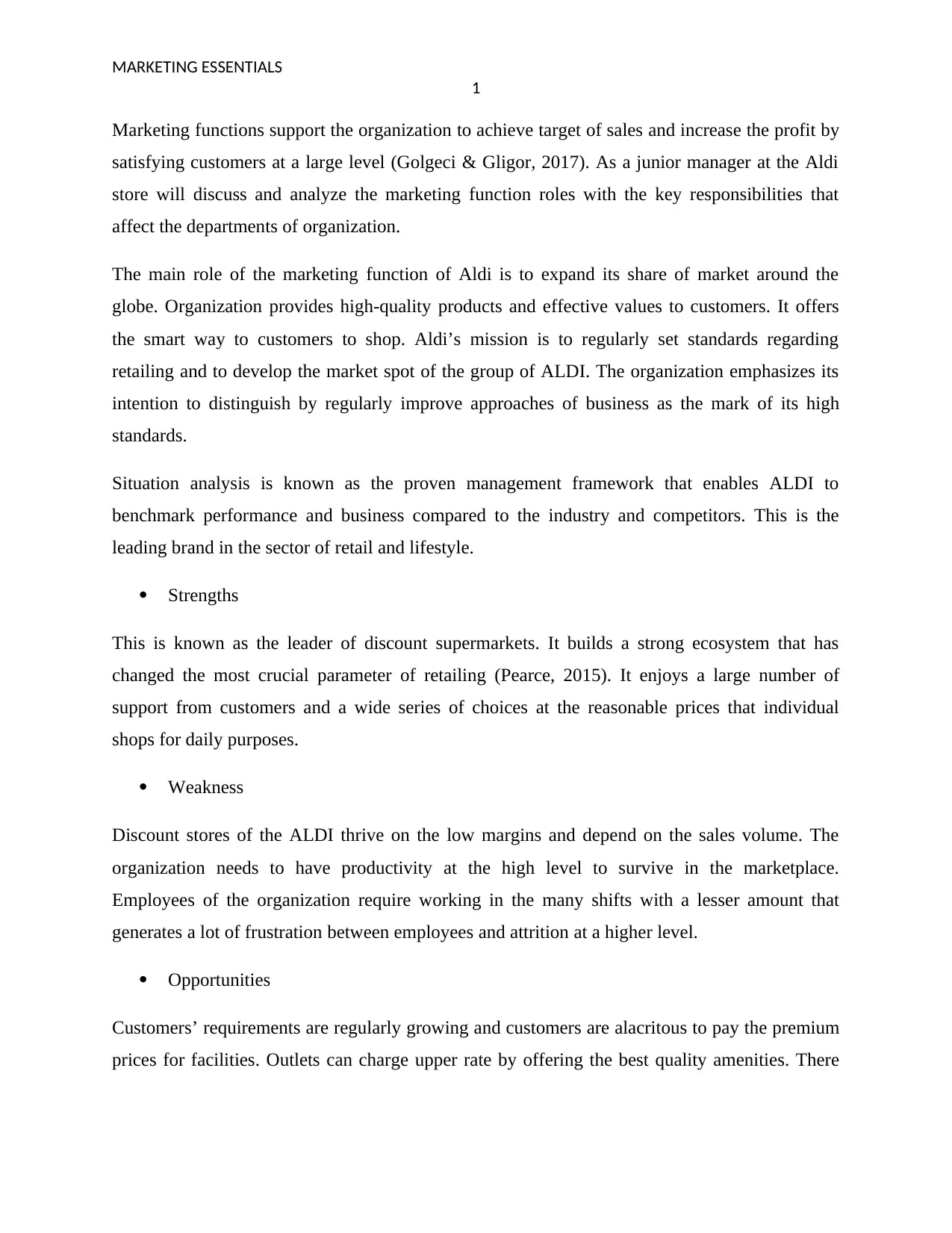
MARKETING ESSENTIALS
1
Marketing functions support the organization to achieve target of sales and increase the profit by
satisfying customers at a large level (Golgeci & Gligor, 2017). As a junior manager at the Aldi
store will discuss and analyze the marketing function roles with the key responsibilities that
affect the departments of organization.
The main role of the marketing function of Aldi is to expand its share of market around the
globe. Organization provides high-quality products and effective values to customers. It offers
the smart way to customers to shop. Aldi’s mission is to regularly set standards regarding
retailing and to develop the market spot of the group of ALDI. The organization emphasizes its
intention to distinguish by regularly improve approaches of business as the mark of its high
standards.
Situation analysis is known as the proven management framework that enables ALDI to
benchmark performance and business compared to the industry and competitors. This is the
leading brand in the sector of retail and lifestyle.
Strengths
This is known as the leader of discount supermarkets. It builds a strong ecosystem that has
changed the most crucial parameter of retailing (Pearce, 2015). It enjoys a large number of
support from customers and a wide series of choices at the reasonable prices that individual
shops for daily purposes.
Weakness
Discount stores of the ALDI thrive on the low margins and depend on the sales volume. The
organization needs to have productivity at the high level to survive in the marketplace.
Employees of the organization require working in the many shifts with a lesser amount that
generates a lot of frustration between employees and attrition at a higher level.
Opportunities
Customers’ requirements are regularly growing and customers are alacritous to pay the premium
prices for facilities. Outlets can charge upper rate by offering the best quality amenities. There
1
Marketing functions support the organization to achieve target of sales and increase the profit by
satisfying customers at a large level (Golgeci & Gligor, 2017). As a junior manager at the Aldi
store will discuss and analyze the marketing function roles with the key responsibilities that
affect the departments of organization.
The main role of the marketing function of Aldi is to expand its share of market around the
globe. Organization provides high-quality products and effective values to customers. It offers
the smart way to customers to shop. Aldi’s mission is to regularly set standards regarding
retailing and to develop the market spot of the group of ALDI. The organization emphasizes its
intention to distinguish by regularly improve approaches of business as the mark of its high
standards.
Situation analysis is known as the proven management framework that enables ALDI to
benchmark performance and business compared to the industry and competitors. This is the
leading brand in the sector of retail and lifestyle.
Strengths
This is known as the leader of discount supermarkets. It builds a strong ecosystem that has
changed the most crucial parameter of retailing (Pearce, 2015). It enjoys a large number of
support from customers and a wide series of choices at the reasonable prices that individual
shops for daily purposes.
Weakness
Discount stores of the ALDI thrive on the low margins and depend on the sales volume. The
organization needs to have productivity at the high level to survive in the marketplace.
Employees of the organization require working in the many shifts with a lesser amount that
generates a lot of frustration between employees and attrition at a higher level.
Opportunities
Customers’ requirements are regularly growing and customers are alacritous to pay the premium
prices for facilities. Outlets can charge upper rate by offering the best quality amenities. There
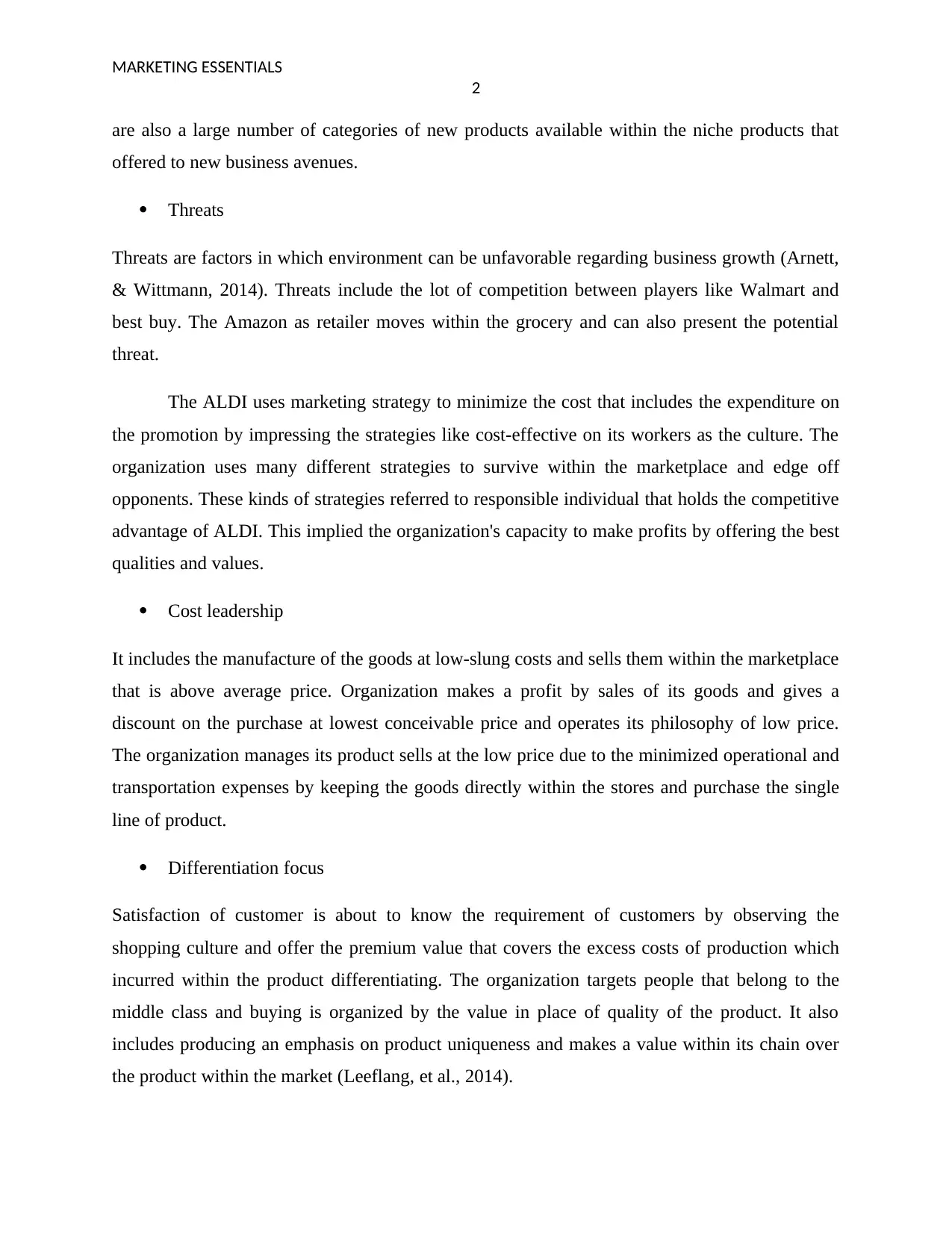
MARKETING ESSENTIALS
2
are also a large number of categories of new products available within the niche products that
offered to new business avenues.
Threats
Threats are factors in which environment can be unfavorable regarding business growth (Arnett,
& Wittmann, 2014). Threats include the lot of competition between players like Walmart and
best buy. The Amazon as retailer moves within the grocery and can also present the potential
threat.
The ALDI uses marketing strategy to minimize the cost that includes the expenditure on
the promotion by impressing the strategies like cost-effective on its workers as the culture. The
organization uses many different strategies to survive within the marketplace and edge off
opponents. These kinds of strategies referred to responsible individual that holds the competitive
advantage of ALDI. This implied the organization's capacity to make profits by offering the best
qualities and values.
Cost leadership
It includes the manufacture of the goods at low-slung costs and sells them within the marketplace
that is above average price. Organization makes a profit by sales of its goods and gives a
discount on the purchase at lowest conceivable price and operates its philosophy of low price.
The organization manages its product sells at the low price due to the minimized operational and
transportation expenses by keeping the goods directly within the stores and purchase the single
line of product.
Differentiation focus
Satisfaction of customer is about to know the requirement of customers by observing the
shopping culture and offer the premium value that covers the excess costs of production which
incurred within the product differentiating. The organization targets people that belong to the
middle class and buying is organized by the value in place of quality of the product. It also
includes producing an emphasis on product uniqueness and makes a value within its chain over
the product within the market (Leeflang, et al., 2014).
2
are also a large number of categories of new products available within the niche products that
offered to new business avenues.
Threats
Threats are factors in which environment can be unfavorable regarding business growth (Arnett,
& Wittmann, 2014). Threats include the lot of competition between players like Walmart and
best buy. The Amazon as retailer moves within the grocery and can also present the potential
threat.
The ALDI uses marketing strategy to minimize the cost that includes the expenditure on
the promotion by impressing the strategies like cost-effective on its workers as the culture. The
organization uses many different strategies to survive within the marketplace and edge off
opponents. These kinds of strategies referred to responsible individual that holds the competitive
advantage of ALDI. This implied the organization's capacity to make profits by offering the best
qualities and values.
Cost leadership
It includes the manufacture of the goods at low-slung costs and sells them within the marketplace
that is above average price. Organization makes a profit by sales of its goods and gives a
discount on the purchase at lowest conceivable price and operates its philosophy of low price.
The organization manages its product sells at the low price due to the minimized operational and
transportation expenses by keeping the goods directly within the stores and purchase the single
line of product.
Differentiation focus
Satisfaction of customer is about to know the requirement of customers by observing the
shopping culture and offer the premium value that covers the excess costs of production which
incurred within the product differentiating. The organization targets people that belong to the
middle class and buying is organized by the value in place of quality of the product. It also
includes producing an emphasis on product uniqueness and makes a value within its chain over
the product within the market (Leeflang, et al., 2014).
⊘ This is a preview!⊘
Do you want full access?
Subscribe today to unlock all pages.

Trusted by 1+ million students worldwide
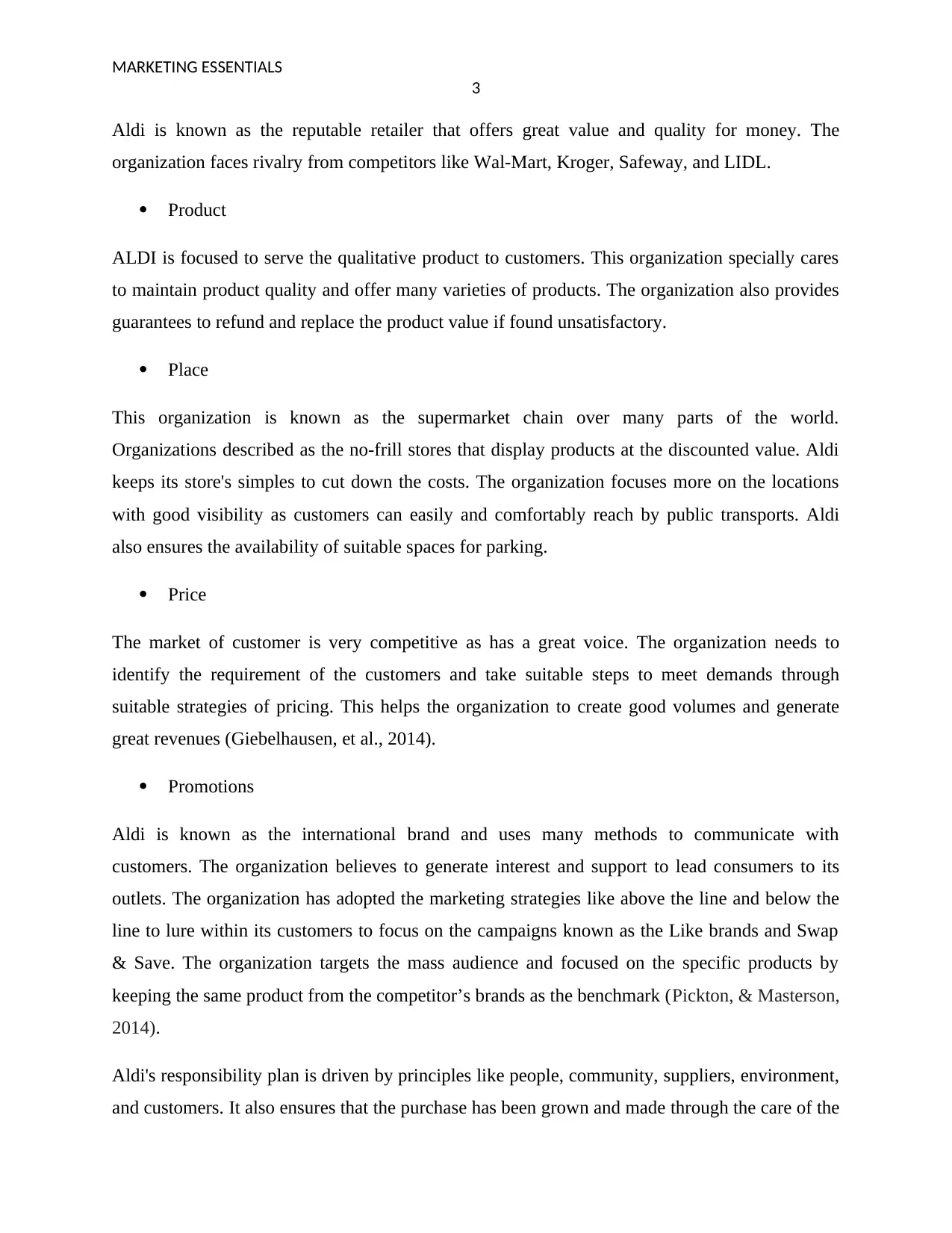
MARKETING ESSENTIALS
3
Aldi is known as the reputable retailer that offers great value and quality for money. The
organization faces rivalry from competitors like Wal-Mart, Kroger, Safeway, and LIDL.
Product
ALDI is focused to serve the qualitative product to customers. This organization specially cares
to maintain product quality and offer many varieties of products. The organization also provides
guarantees to refund and replace the product value if found unsatisfactory.
Place
This organization is known as the supermarket chain over many parts of the world.
Organizations described as the no-frill stores that display products at the discounted value. Aldi
keeps its store's simples to cut down the costs. The organization focuses more on the locations
with good visibility as customers can easily and comfortably reach by public transports. Aldi
also ensures the availability of suitable spaces for parking.
Price
The market of customer is very competitive as has a great voice. The organization needs to
identify the requirement of the customers and take suitable steps to meet demands through
suitable strategies of pricing. This helps the organization to create good volumes and generate
great revenues (Giebelhausen, et al., 2014).
Promotions
Aldi is known as the international brand and uses many methods to communicate with
customers. The organization believes to generate interest and support to lead consumers to its
outlets. The organization has adopted the marketing strategies like above the line and below the
line to lure within its customers to focus on the campaigns known as the Like brands and Swap
& Save. The organization targets the mass audience and focused on the specific products by
keeping the same product from the competitor’s brands as the benchmark (Pickton, & Masterson,
2014).
Aldi's responsibility plan is driven by principles like people, community, suppliers, environment,
and customers. It also ensures that the purchase has been grown and made through the care of the
3
Aldi is known as the reputable retailer that offers great value and quality for money. The
organization faces rivalry from competitors like Wal-Mart, Kroger, Safeway, and LIDL.
Product
ALDI is focused to serve the qualitative product to customers. This organization specially cares
to maintain product quality and offer many varieties of products. The organization also provides
guarantees to refund and replace the product value if found unsatisfactory.
Place
This organization is known as the supermarket chain over many parts of the world.
Organizations described as the no-frill stores that display products at the discounted value. Aldi
keeps its store's simples to cut down the costs. The organization focuses more on the locations
with good visibility as customers can easily and comfortably reach by public transports. Aldi
also ensures the availability of suitable spaces for parking.
Price
The market of customer is very competitive as has a great voice. The organization needs to
identify the requirement of the customers and take suitable steps to meet demands through
suitable strategies of pricing. This helps the organization to create good volumes and generate
great revenues (Giebelhausen, et al., 2014).
Promotions
Aldi is known as the international brand and uses many methods to communicate with
customers. The organization believes to generate interest and support to lead consumers to its
outlets. The organization has adopted the marketing strategies like above the line and below the
line to lure within its customers to focus on the campaigns known as the Like brands and Swap
& Save. The organization targets the mass audience and focused on the specific products by
keeping the same product from the competitor’s brands as the benchmark (Pickton, & Masterson,
2014).
Aldi's responsibility plan is driven by principles like people, community, suppliers, environment,
and customers. It also ensures that the purchase has been grown and made through the care of the
Paraphrase This Document
Need a fresh take? Get an instant paraphrase of this document with our AI Paraphraser
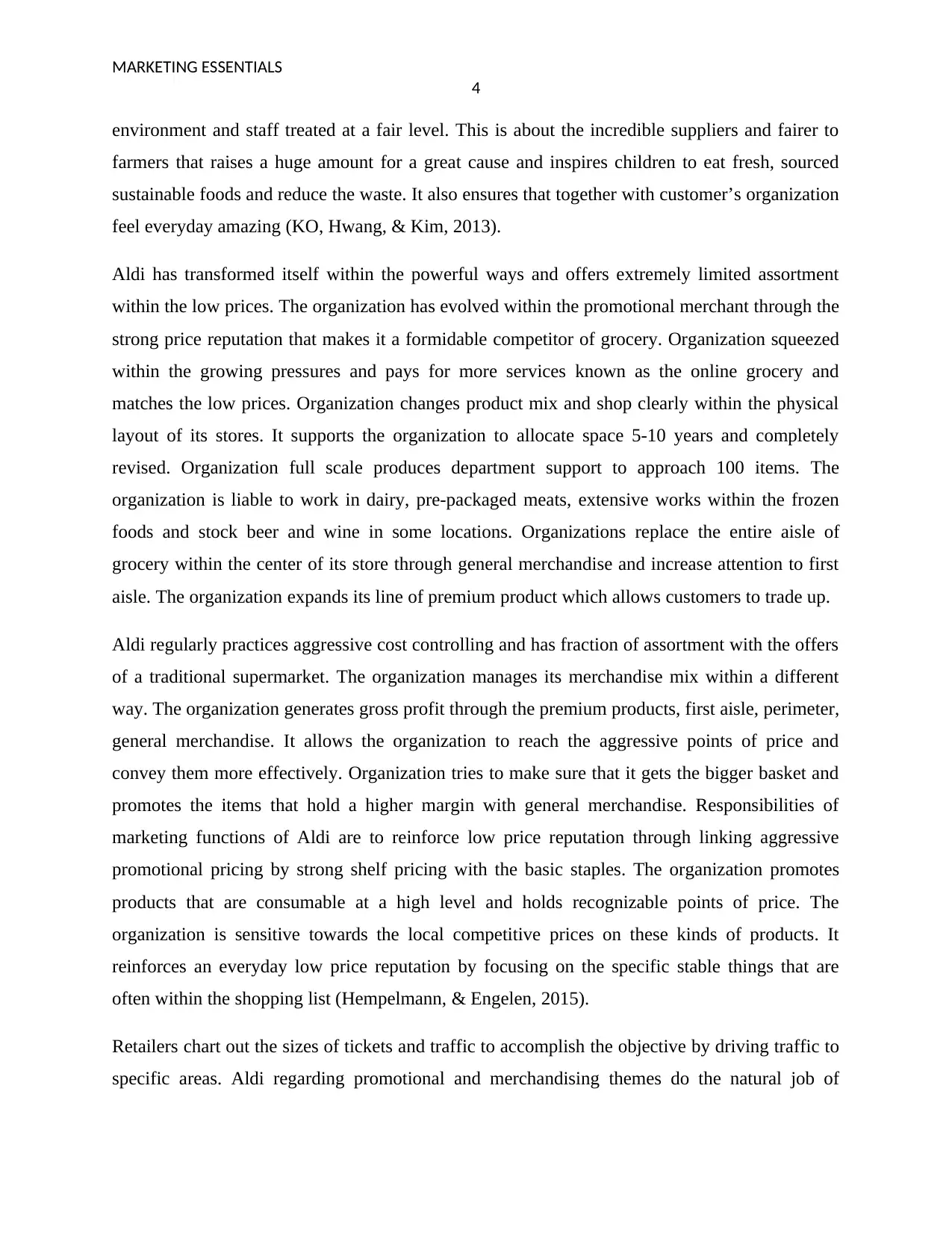
MARKETING ESSENTIALS
4
environment and staff treated at a fair level. This is about the incredible suppliers and fairer to
farmers that raises a huge amount for a great cause and inspires children to eat fresh, sourced
sustainable foods and reduce the waste. It also ensures that together with customer’s organization
feel everyday amazing (KO, Hwang, & Kim, 2013).
Aldi has transformed itself within the powerful ways and offers extremely limited assortment
within the low prices. The organization has evolved within the promotional merchant through the
strong price reputation that makes it a formidable competitor of grocery. Organization squeezed
within the growing pressures and pays for more services known as the online grocery and
matches the low prices. Organization changes product mix and shop clearly within the physical
layout of its stores. It supports the organization to allocate space 5-10 years and completely
revised. Organization full scale produces department support to approach 100 items. The
organization is liable to work in dairy, pre-packaged meats, extensive works within the frozen
foods and stock beer and wine in some locations. Organizations replace the entire aisle of
grocery within the center of its store through general merchandise and increase attention to first
aisle. The organization expands its line of premium product which allows customers to trade up.
Aldi regularly practices aggressive cost controlling and has fraction of assortment with the offers
of a traditional supermarket. The organization manages its merchandise mix within a different
way. The organization generates gross profit through the premium products, first aisle, perimeter,
general merchandise. It allows the organization to reach the aggressive points of price and
convey them more effectively. Organization tries to make sure that it gets the bigger basket and
promotes the items that hold a higher margin with general merchandise. Responsibilities of
marketing functions of Aldi are to reinforce low price reputation through linking aggressive
promotional pricing by strong shelf pricing with the basic staples. The organization promotes
products that are consumable at a high level and holds recognizable points of price. The
organization is sensitive towards the local competitive prices on these kinds of products. It
reinforces an everyday low price reputation by focusing on the specific stable things that are
often within the shopping list (Hempelmann, & Engelen, 2015).
Retailers chart out the sizes of tickets and traffic to accomplish the objective by driving traffic to
specific areas. Aldi regarding promotional and merchandising themes do the natural job of
4
environment and staff treated at a fair level. This is about the incredible suppliers and fairer to
farmers that raises a huge amount for a great cause and inspires children to eat fresh, sourced
sustainable foods and reduce the waste. It also ensures that together with customer’s organization
feel everyday amazing (KO, Hwang, & Kim, 2013).
Aldi has transformed itself within the powerful ways and offers extremely limited assortment
within the low prices. The organization has evolved within the promotional merchant through the
strong price reputation that makes it a formidable competitor of grocery. Organization squeezed
within the growing pressures and pays for more services known as the online grocery and
matches the low prices. Organization changes product mix and shop clearly within the physical
layout of its stores. It supports the organization to allocate space 5-10 years and completely
revised. Organization full scale produces department support to approach 100 items. The
organization is liable to work in dairy, pre-packaged meats, extensive works within the frozen
foods and stock beer and wine in some locations. Organizations replace the entire aisle of
grocery within the center of its store through general merchandise and increase attention to first
aisle. The organization expands its line of premium product which allows customers to trade up.
Aldi regularly practices aggressive cost controlling and has fraction of assortment with the offers
of a traditional supermarket. The organization manages its merchandise mix within a different
way. The organization generates gross profit through the premium products, first aisle, perimeter,
general merchandise. It allows the organization to reach the aggressive points of price and
convey them more effectively. Organization tries to make sure that it gets the bigger basket and
promotes the items that hold a higher margin with general merchandise. Responsibilities of
marketing functions of Aldi are to reinforce low price reputation through linking aggressive
promotional pricing by strong shelf pricing with the basic staples. The organization promotes
products that are consumable at a high level and holds recognizable points of price. The
organization is sensitive towards the local competitive prices on these kinds of products. It
reinforces an everyday low price reputation by focusing on the specific stable things that are
often within the shopping list (Hempelmann, & Engelen, 2015).
Retailers chart out the sizes of tickets and traffic to accomplish the objective by driving traffic to
specific areas. Aldi regarding promotional and merchandising themes do the natural job of
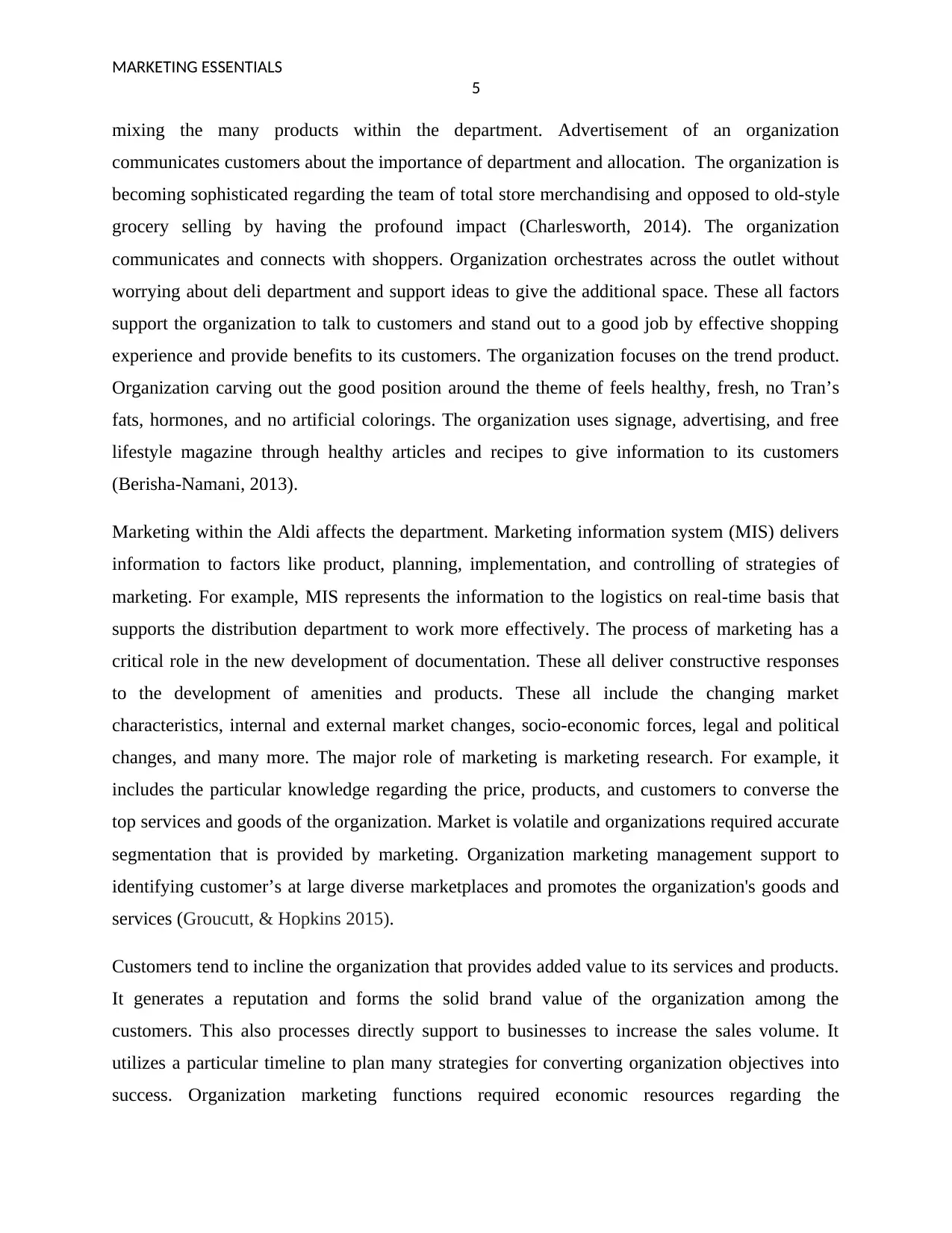
MARKETING ESSENTIALS
5
mixing the many products within the department. Advertisement of an organization
communicates customers about the importance of department and allocation. The organization is
becoming sophisticated regarding the team of total store merchandising and opposed to old-style
grocery selling by having the profound impact (Charlesworth, 2014). The organization
communicates and connects with shoppers. Organization orchestrates across the outlet without
worrying about deli department and support ideas to give the additional space. These all factors
support the organization to talk to customers and stand out to a good job by effective shopping
experience and provide benefits to its customers. The organization focuses on the trend product.
Organization carving out the good position around the theme of feels healthy, fresh, no Tran’s
fats, hormones, and no artificial colorings. The organization uses signage, advertising, and free
lifestyle magazine through healthy articles and recipes to give information to its customers
(Berisha-Namani, 2013).
Marketing within the Aldi affects the department. Marketing information system (MIS) delivers
information to factors like product, planning, implementation, and controlling of strategies of
marketing. For example, MIS represents the information to the logistics on real-time basis that
supports the distribution department to work more effectively. The process of marketing has a
critical role in the new development of documentation. These all deliver constructive responses
to the development of amenities and products. These all include the changing market
characteristics, internal and external market changes, socio-economic forces, legal and political
changes, and many more. The major role of marketing is marketing research. For example, it
includes the particular knowledge regarding the price, products, and customers to converse the
top services and goods of the organization. Market is volatile and organizations required accurate
segmentation that is provided by marketing. Organization marketing management support to
identifying customer’s at large diverse marketplaces and promotes the organization's goods and
services (Groucutt, & Hopkins 2015).
Customers tend to incline the organization that provides added value to its services and products.
It generates a reputation and forms the solid brand value of the organization among the
customers. This also processes directly support to businesses to increase the sales volume. It
utilizes a particular timeline to plan many strategies for converting organization objectives into
success. Organization marketing functions required economic resources regarding the
5
mixing the many products within the department. Advertisement of an organization
communicates customers about the importance of department and allocation. The organization is
becoming sophisticated regarding the team of total store merchandising and opposed to old-style
grocery selling by having the profound impact (Charlesworth, 2014). The organization
communicates and connects with shoppers. Organization orchestrates across the outlet without
worrying about deli department and support ideas to give the additional space. These all factors
support the organization to talk to customers and stand out to a good job by effective shopping
experience and provide benefits to its customers. The organization focuses on the trend product.
Organization carving out the good position around the theme of feels healthy, fresh, no Tran’s
fats, hormones, and no artificial colorings. The organization uses signage, advertising, and free
lifestyle magazine through healthy articles and recipes to give information to its customers
(Berisha-Namani, 2013).
Marketing within the Aldi affects the department. Marketing information system (MIS) delivers
information to factors like product, planning, implementation, and controlling of strategies of
marketing. For example, MIS represents the information to the logistics on real-time basis that
supports the distribution department to work more effectively. The process of marketing has a
critical role in the new development of documentation. These all deliver constructive responses
to the development of amenities and products. These all include the changing market
characteristics, internal and external market changes, socio-economic forces, legal and political
changes, and many more. The major role of marketing is marketing research. For example, it
includes the particular knowledge regarding the price, products, and customers to converse the
top services and goods of the organization. Market is volatile and organizations required accurate
segmentation that is provided by marketing. Organization marketing management support to
identifying customer’s at large diverse marketplaces and promotes the organization's goods and
services (Groucutt, & Hopkins 2015).
Customers tend to incline the organization that provides added value to its services and products.
It generates a reputation and forms the solid brand value of the organization among the
customers. This also processes directly support to businesses to increase the sales volume. It
utilizes a particular timeline to plan many strategies for converting organization objectives into
success. Organization marketing functions required economic resources regarding the
⊘ This is a preview!⊘
Do you want full access?
Subscribe today to unlock all pages.

Trusted by 1+ million students worldwide
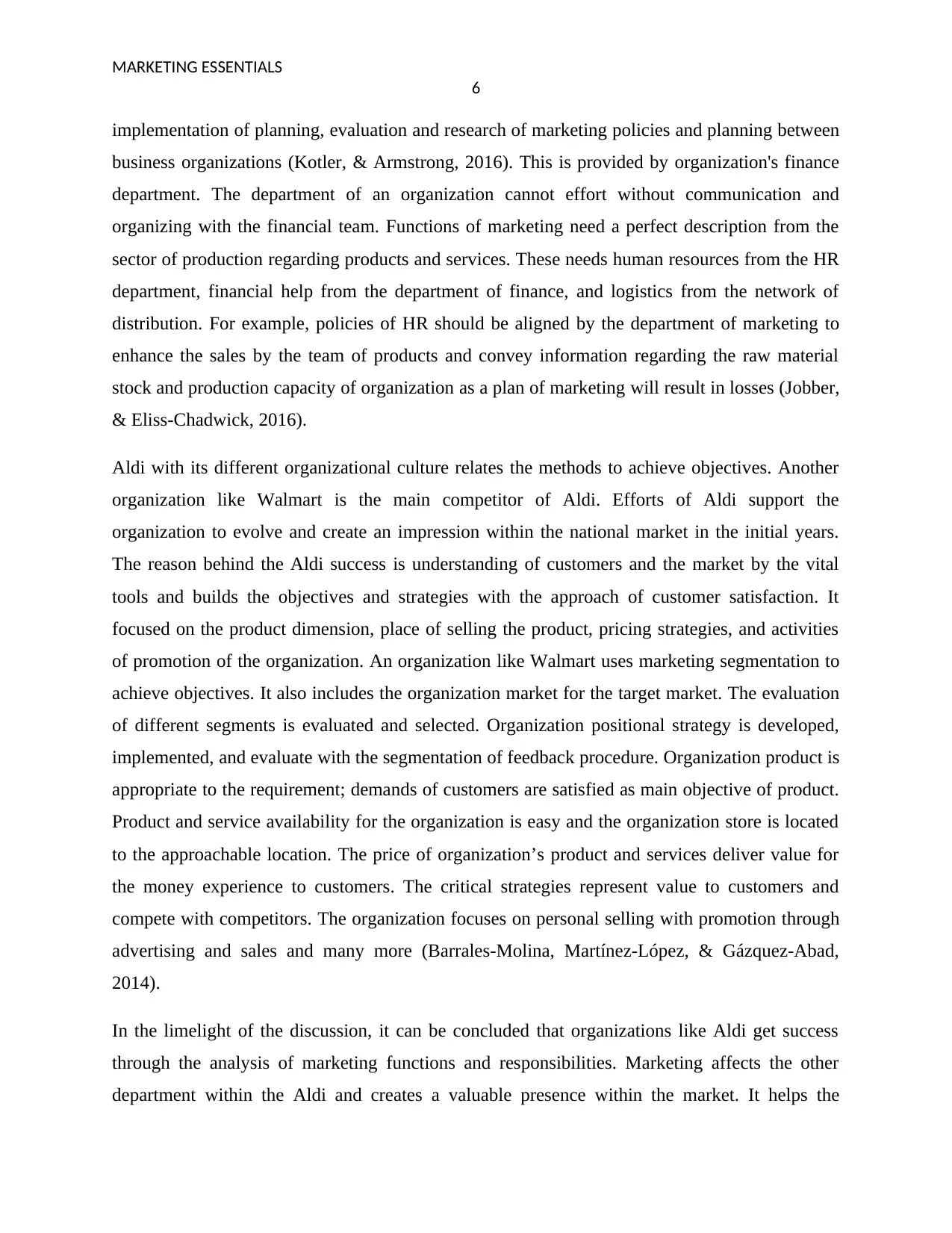
MARKETING ESSENTIALS
6
implementation of planning, evaluation and research of marketing policies and planning between
business organizations (Kotler, & Armstrong, 2016). This is provided by organization's finance
department. The department of an organization cannot effort without communication and
organizing with the financial team. Functions of marketing need a perfect description from the
sector of production regarding products and services. These needs human resources from the HR
department, financial help from the department of finance, and logistics from the network of
distribution. For example, policies of HR should be aligned by the department of marketing to
enhance the sales by the team of products and convey information regarding the raw material
stock and production capacity of organization as a plan of marketing will result in losses (Jobber,
& Eliss-Chadwick, 2016).
Aldi with its different organizational culture relates the methods to achieve objectives. Another
organization like Walmart is the main competitor of Aldi. Efforts of Aldi support the
organization to evolve and create an impression within the national market in the initial years.
The reason behind the Aldi success is understanding of customers and the market by the vital
tools and builds the objectives and strategies with the approach of customer satisfaction. It
focused on the product dimension, place of selling the product, pricing strategies, and activities
of promotion of the organization. An organization like Walmart uses marketing segmentation to
achieve objectives. It also includes the organization market for the target market. The evaluation
of different segments is evaluated and selected. Organization positional strategy is developed,
implemented, and evaluate with the segmentation of feedback procedure. Organization product is
appropriate to the requirement; demands of customers are satisfied as main objective of product.
Product and service availability for the organization is easy and the organization store is located
to the approachable location. The price of organization’s product and services deliver value for
the money experience to customers. The critical strategies represent value to customers and
compete with competitors. The organization focuses on personal selling with promotion through
advertising and sales and many more (Barrales‐Molina, Martínez‐López, & Gázquez‐Abad,
2014).
In the limelight of the discussion, it can be concluded that organizations like Aldi get success
through the analysis of marketing functions and responsibilities. Marketing affects the other
department within the Aldi and creates a valuable presence within the market. It helps the
6
implementation of planning, evaluation and research of marketing policies and planning between
business organizations (Kotler, & Armstrong, 2016). This is provided by organization's finance
department. The department of an organization cannot effort without communication and
organizing with the financial team. Functions of marketing need a perfect description from the
sector of production regarding products and services. These needs human resources from the HR
department, financial help from the department of finance, and logistics from the network of
distribution. For example, policies of HR should be aligned by the department of marketing to
enhance the sales by the team of products and convey information regarding the raw material
stock and production capacity of organization as a plan of marketing will result in losses (Jobber,
& Eliss-Chadwick, 2016).
Aldi with its different organizational culture relates the methods to achieve objectives. Another
organization like Walmart is the main competitor of Aldi. Efforts of Aldi support the
organization to evolve and create an impression within the national market in the initial years.
The reason behind the Aldi success is understanding of customers and the market by the vital
tools and builds the objectives and strategies with the approach of customer satisfaction. It
focused on the product dimension, place of selling the product, pricing strategies, and activities
of promotion of the organization. An organization like Walmart uses marketing segmentation to
achieve objectives. It also includes the organization market for the target market. The evaluation
of different segments is evaluated and selected. Organization positional strategy is developed,
implemented, and evaluate with the segmentation of feedback procedure. Organization product is
appropriate to the requirement; demands of customers are satisfied as main objective of product.
Product and service availability for the organization is easy and the organization store is located
to the approachable location. The price of organization’s product and services deliver value for
the money experience to customers. The critical strategies represent value to customers and
compete with competitors. The organization focuses on personal selling with promotion through
advertising and sales and many more (Barrales‐Molina, Martínez‐López, & Gázquez‐Abad,
2014).
In the limelight of the discussion, it can be concluded that organizations like Aldi get success
through the analysis of marketing functions and responsibilities. Marketing affects the other
department within the Aldi and creates a valuable presence within the market. It helps the
Paraphrase This Document
Need a fresh take? Get an instant paraphrase of this document with our AI Paraphraser
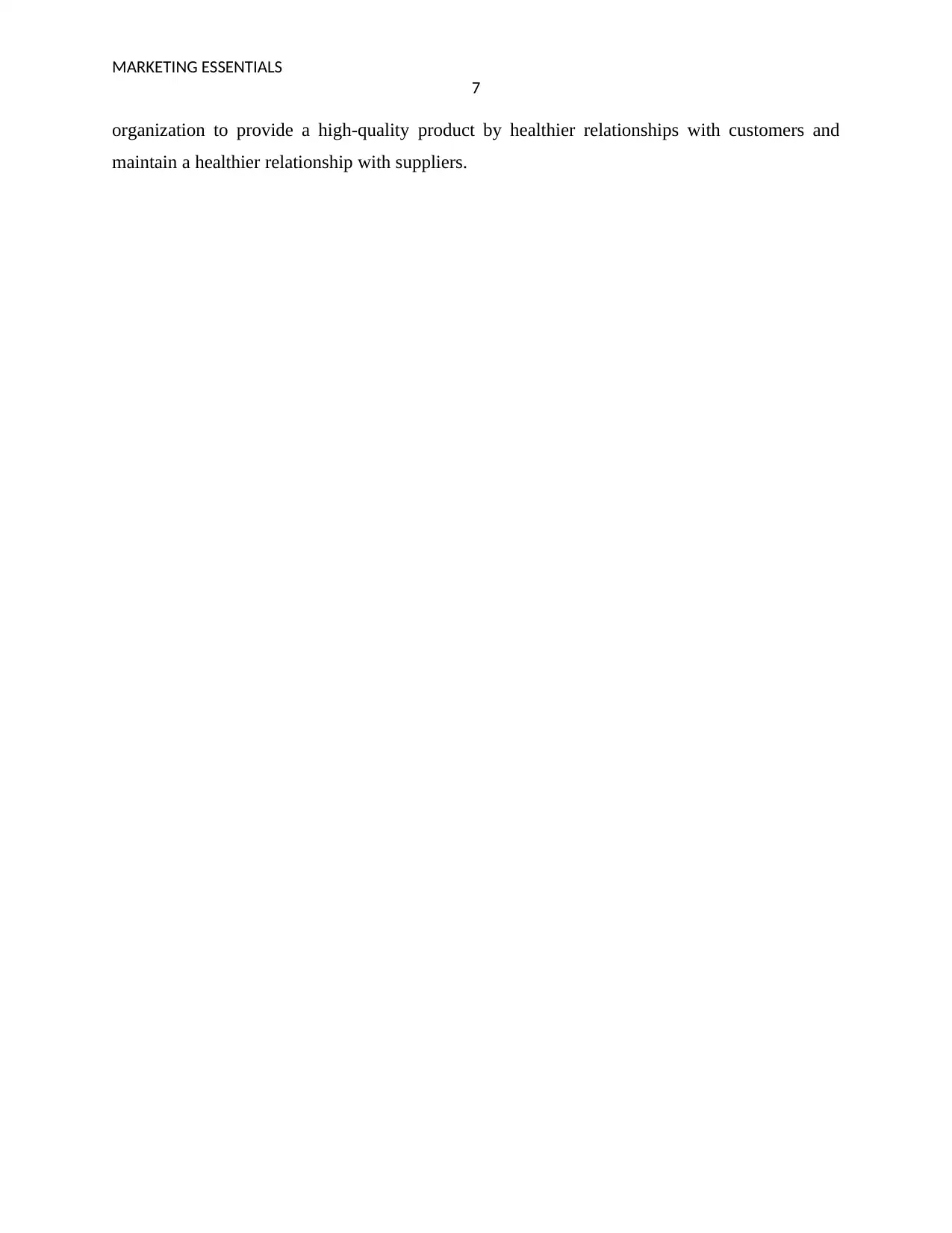
MARKETING ESSENTIALS
7
organization to provide a high-quality product by healthier relationships with customers and
maintain a healthier relationship with suppliers.
7
organization to provide a high-quality product by healthier relationships with customers and
maintain a healthier relationship with suppliers.
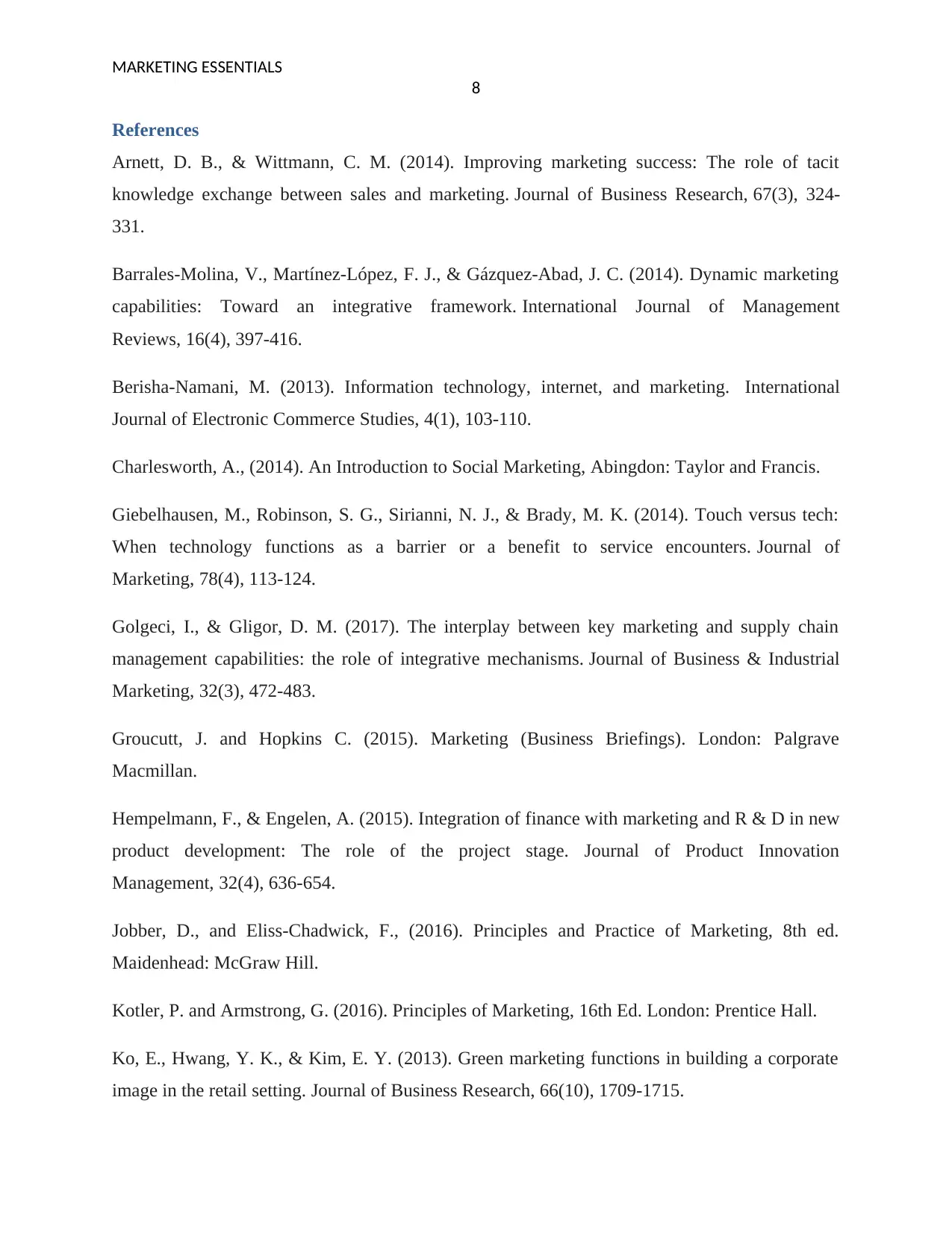
MARKETING ESSENTIALS
8
References
Arnett, D. B., & Wittmann, C. M. (2014). Improving marketing success: The role of tacit
knowledge exchange between sales and marketing. Journal of Business Research, 67(3), 324-
331.
Barrales‐Molina, V., Martínez‐López, F. J., & Gázquez‐Abad, J. C. (2014). Dynamic marketing
capabilities: Toward an integrative framework. International Journal of Management
Reviews, 16(4), 397-416.
Berisha-Namani, M. (2013). Information technology, internet, and marketing. International
Journal of Electronic Commerce Studies, 4(1), 103-110.
Charlesworth, A., (2014). An Introduction to Social Marketing, Abingdon: Taylor and Francis.
Giebelhausen, M., Robinson, S. G., Sirianni, N. J., & Brady, M. K. (2014). Touch versus tech:
When technology functions as a barrier or a benefit to service encounters. Journal of
Marketing, 78(4), 113-124.
Golgeci, I., & Gligor, D. M. (2017). The interplay between key marketing and supply chain
management capabilities: the role of integrative mechanisms. Journal of Business & Industrial
Marketing, 32(3), 472-483.
Groucutt, J. and Hopkins C. (2015). Marketing (Business Briefings). London: Palgrave
Macmillan.
Hempelmann, F., & Engelen, A. (2015). Integration of finance with marketing and R & D in new
product development: The role of the project stage. Journal of Product Innovation
Management, 32(4), 636-654.
Jobber, D., and Eliss-Chadwick, F., (2016). Principles and Practice of Marketing, 8th ed.
Maidenhead: McGraw Hill.
Kotler, P. and Armstrong, G. (2016). Principles of Marketing, 16th Ed. London: Prentice Hall.
Ko, E., Hwang, Y. K., & Kim, E. Y. (2013). Green marketing functions in building a corporate
image in the retail setting. Journal of Business Research, 66(10), 1709-1715.
8
References
Arnett, D. B., & Wittmann, C. M. (2014). Improving marketing success: The role of tacit
knowledge exchange between sales and marketing. Journal of Business Research, 67(3), 324-
331.
Barrales‐Molina, V., Martínez‐López, F. J., & Gázquez‐Abad, J. C. (2014). Dynamic marketing
capabilities: Toward an integrative framework. International Journal of Management
Reviews, 16(4), 397-416.
Berisha-Namani, M. (2013). Information technology, internet, and marketing. International
Journal of Electronic Commerce Studies, 4(1), 103-110.
Charlesworth, A., (2014). An Introduction to Social Marketing, Abingdon: Taylor and Francis.
Giebelhausen, M., Robinson, S. G., Sirianni, N. J., & Brady, M. K. (2014). Touch versus tech:
When technology functions as a barrier or a benefit to service encounters. Journal of
Marketing, 78(4), 113-124.
Golgeci, I., & Gligor, D. M. (2017). The interplay between key marketing and supply chain
management capabilities: the role of integrative mechanisms. Journal of Business & Industrial
Marketing, 32(3), 472-483.
Groucutt, J. and Hopkins C. (2015). Marketing (Business Briefings). London: Palgrave
Macmillan.
Hempelmann, F., & Engelen, A. (2015). Integration of finance with marketing and R & D in new
product development: The role of the project stage. Journal of Product Innovation
Management, 32(4), 636-654.
Jobber, D., and Eliss-Chadwick, F., (2016). Principles and Practice of Marketing, 8th ed.
Maidenhead: McGraw Hill.
Kotler, P. and Armstrong, G. (2016). Principles of Marketing, 16th Ed. London: Prentice Hall.
Ko, E., Hwang, Y. K., & Kim, E. Y. (2013). Green marketing functions in building a corporate
image in the retail setting. Journal of Business Research, 66(10), 1709-1715.
⊘ This is a preview!⊘
Do you want full access?
Subscribe today to unlock all pages.

Trusted by 1+ million students worldwide
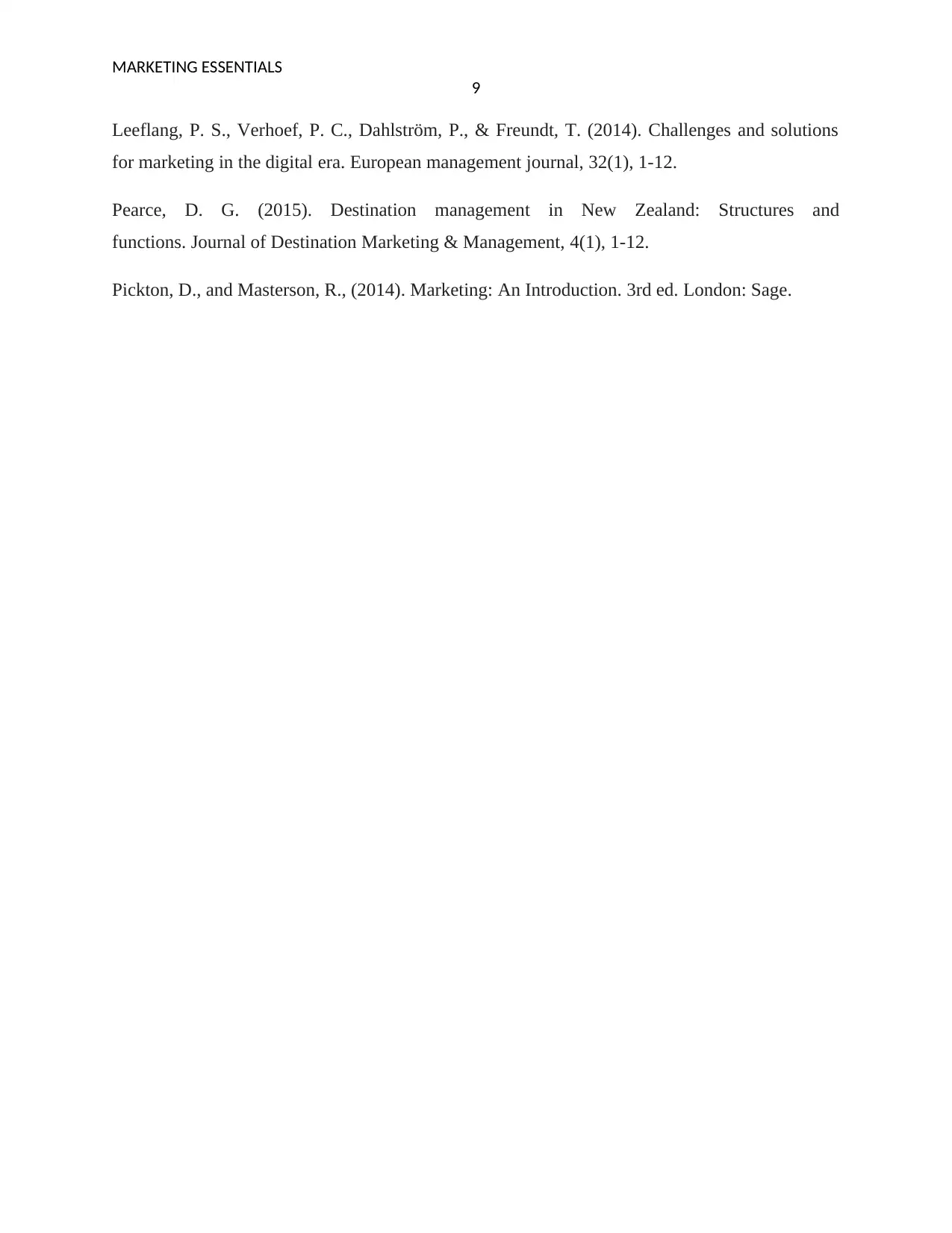
MARKETING ESSENTIALS
9
Leeflang, P. S., Verhoef, P. C., Dahlström, P., & Freundt, T. (2014). Challenges and solutions
for marketing in the digital era. European management journal, 32(1), 1-12.
Pearce, D. G. (2015). Destination management in New Zealand: Structures and
functions. Journal of Destination Marketing & Management, 4(1), 1-12.
Pickton, D., and Masterson, R., (2014). Marketing: An Introduction. 3rd ed. London: Sage.
9
Leeflang, P. S., Verhoef, P. C., Dahlström, P., & Freundt, T. (2014). Challenges and solutions
for marketing in the digital era. European management journal, 32(1), 1-12.
Pearce, D. G. (2015). Destination management in New Zealand: Structures and
functions. Journal of Destination Marketing & Management, 4(1), 1-12.
Pickton, D., and Masterson, R., (2014). Marketing: An Introduction. 3rd ed. London: Sage.
1 out of 10
Related Documents
Your All-in-One AI-Powered Toolkit for Academic Success.
+13062052269
info@desklib.com
Available 24*7 on WhatsApp / Email
![[object Object]](/_next/static/media/star-bottom.7253800d.svg)
Unlock your academic potential
Copyright © 2020–2025 A2Z Services. All Rights Reserved. Developed and managed by ZUCOL.





